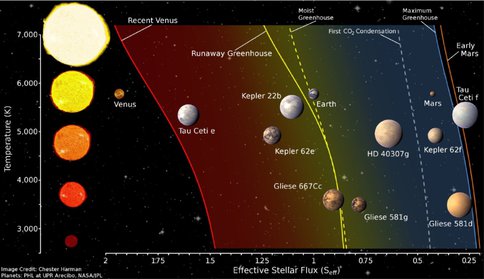2013 Annual Science Report
 Pennsylvania State University
Reporting | SEP 2012 – AUG 2013
Pennsylvania State University
Reporting | SEP 2012 – AUG 2013
Biosignatures in Ancient Rocks - Kasting Group
Project Summary
The work by Ramirez concerned updating the absorption coefficients in our 1-D climate model. Harman’s work consisted of developing a 1-D code for modeling hydrodynamic escape of hydrogen from rocky planets.
Project Progress
Here, we will just describe the major result of paper (i) below. Because of higher absorption of solar visible/near-IR radiation by H2O, the inner edge of the liquid water habitable zone around the Sun has moved significantly outwards, from ~0.95 astronomical units (AU) to 0.99 AU. A figure showing the new habitable zone boundaries for different types of stars in terms of effective stellar flux is shown in Fig. 1 below.
Diagram showing different HZ boundaries for stars ranging in spectral type from F0 to M7. The “1st CO2 condensation” limit is no longer considered valid for the outer edge, for reasons discussed in the text. Various planets within our Solar System are shown, along with selected exoplanets. [From Kasting et al., PNAS, submitted (ref. iii) above]
Additional research described in our other papers shows that early Mars could have been warmed above the freezing point of water by the greenhouse effect of a CO2-H2 atmosphere. We also showed that increases in atmospheric CO2 cannot cause a runaway greenhouse on Earth, no matter how much CO2 is added.
-
PROJECT INVESTIGATORS:
-
PROJECT MEMBERS:
Nathan Barber
Co-Investigator
Jamie Brainard
Co-Investigator
James Fulton
Co-Investigator
Hiroshi Hamasaki
Co-Investigator
Matthew Heinicke
Co-Investigator
Lev Horodyskyj
Co-Investigator
Stamatina Hunter
Co-Investigator
Ian Johnson
Co-Investigator
Genming Luo
Co-Investigator
Yumiko Watanabe
Co-Investigator
Fabia Battistuzzi
Collaborator
Ying Cui
Collaborator
James Farquhar
Collaborator
Christopher Junium
Collaborator
Sudhir Kumar
Collaborator
Timothy White
Collaborator
Aubrey Zerkle
Collaborator
-
RELATED OBJECTIVES:
Objective 1.1
Formation and evolution of habitable planets.
Objective 3.2
Origins and evolution of functional biomolecules
Objective 4.1
Earth's early biosphere.
Objective 4.2
Production of complex life.
Objective 4.3
Effects of extraterrestrial events upon the biosphere
Objective 5.1
Environment-dependent, molecular evolution in microorganisms
Objective 5.2
Co-evolution of microbial communities
Objective 5.3
Biochemical adaptation to extreme environments
Objective 6.1
Effects of environmental changes on microbial ecosystems
Objective 6.2
Adaptation and evolution of life beyond Earth
Objective 7.1
Biosignatures to be sought in Solar System materials
Objective 7.2
Biosignatures to be sought in nearby planetary systems





